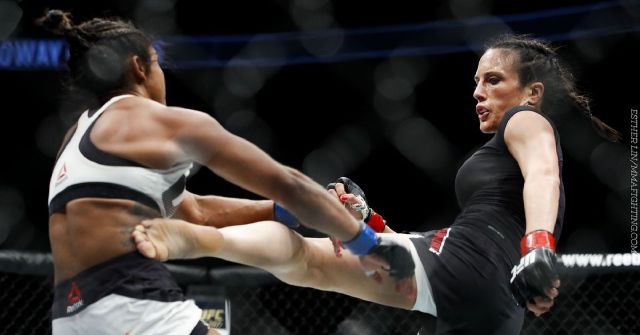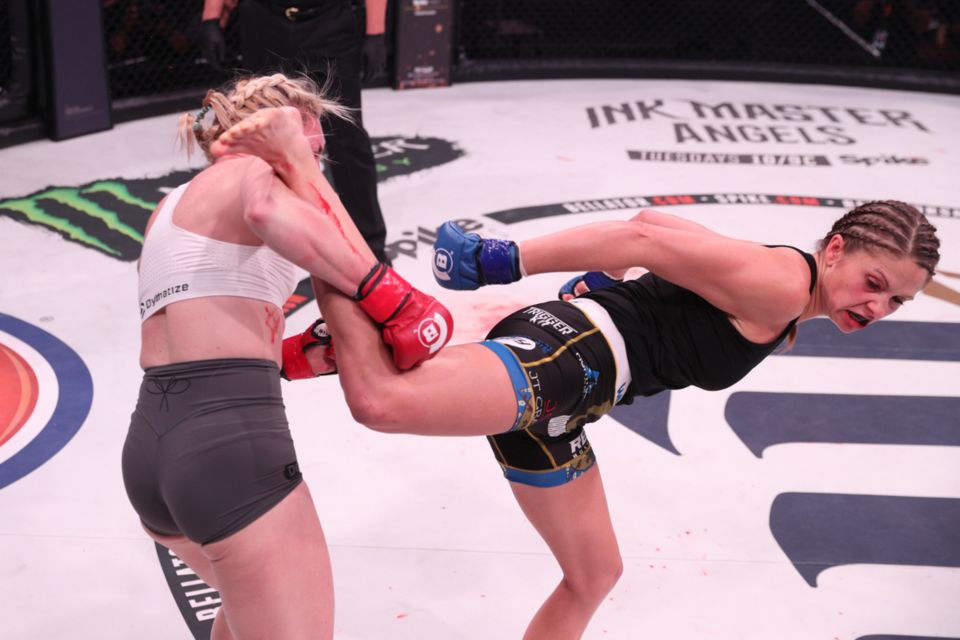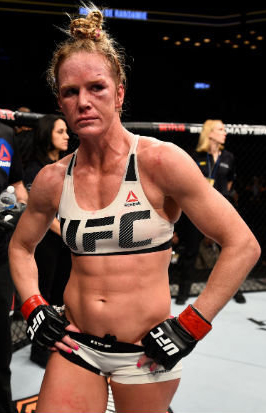This Friday night at Bellator 201 we have a fight featuring Kristina Williams, a mixed martial arts newcomer and the hottest fighter in Bellator MMA’s flyweight division. The 2-0 fighter arrived on the scene with two high profile wins — the first over world champion boxer and previously undefeated Heather Hardy, and the second over consensus #2 fighter in the division and former title challenger Emily Ducote. In winning those two fights, Williams established herself as a dark horse in the division and was placed on the fast track to the elite status in the division. This has put her on a collision course with former UFC strawweight title challenger, big name Bellator signee, and the subject of this article, Valerie “Trouble” Letourneau. This fight, in my opinion, will determine the second best fighter in the division and the next title challenger. Today I will be discussing the things Letourneau needs to do and not do to make sure that she gets her second chance at championship gold.
DO Counter Aggressively
Williams likes to use a combination of her length and forward motion to limit her opponents’ offensive outbursts and to expose the limitations in their footwork. To dissuade Williams from attempting to repeat this feat, Letourneau will have to consistently and aggressively counter her at every turn. There are three specific weapons Letourneau can use. The first is leg and body kicking — Williams is heavy on the front foot and has a tendency to telegraph strikes, which makes her very vulnerable to strikes to the leg and body. The second is long right hands, as Williams uses little to no angles or head movement in applying pressure, which leaves her open to these strikes as she comes in on straight lines and doesn’t move her head or keep her chin down enough to shield herself. Hardy and Ducote had a field day landing these shots, but neither had the length or footwork to follow up, a problem Letourneau doesn’t have. This will allow her to take further advantage of the aforementioned issues by using the third weapon — a left hook, which can follow up the right hand or be used it as a check hook for when Williams overpursues (as she does often).
A second set of issues that Williams has is her lack of cohesion in her striking and creativity; essentially she either punches — channeling old school Donald Cerrone pushing shots and unbalancing herself — or she resorts to telegraphed or naked kicks. Either way, these approaches will allow Letourneau to make quick and precise reads that not only allow for lanes to land counterstrikes, but they also create opportunities to land reactive takedowns. The first way it does so is that when Williams initiates punches or elbows, she tends to reach, overextending and offering up a clear path to her hips for a takedown. The second and most likely way this creates opportunities for takedowns is that the lack of setup and the predictability of her kicks allows for them to be caught and repeatedly turned into takedowns. Letourneau is excellent at this, having done it against Joanna Jedrzejczyk and Joanne Calderwood, and we witnessed it being done to Williams repeatedly by Ducote.
These counters, whether takedown or strike, will help limit what weapons Williams uses, as well as where and when she uses them. This will allow Letourneau more freedom on the feet and in regards to takedowns and takedown attempts, mostly as a result of being able to get Williams to show her hand, and mixing up the responses to it.
DO Punish the Body
A key element in Kristina Williams’ success at flyweight is her durability. She has yet to show herself to be a defensively sound fighter, ignoring defensive measures in large part because of her length, height, and kicking game, working in conjunction with her physicality and durability. To put it in layman’s terms, Williams’ ability to attack from distances that others can’t attack or counter from has resulted in her lack of progression defensively, because most fighters don’t have the footwork and skill to get to her with enough volume to do real damage. On top of that, Williams is both extremely durable and physical, meaning she can take hard shots (especially singular ones) and has the ability to make you pay for any offensive outbursts. Williams is a big, long flyweight — being big helps her absorb punishment, but being long makes her particularly susceptible to a consistent and concentrated body attack. The body is always there to be touched, much easier than the head; it just takes a fighter who is willing to attack the body, and has the skills and savvy to get to it in the face of leads or counters from an opponent.
Ducote showed flashes of success with body kicks against Williams. Letourneau is a much more seasoned fighter, a much more refined striker, and a much more natural striker than Ducote, having shown a busy, consistent body kicking (and punching) game against world class opposition like Maryna Moroz, Jedrzejczyk, and Calderwood. More importantly, Letourneau has shown knees to the body in clinches against Viviane Pereira and Elizabeth Phillips, which guarantees that she can get to Williams’ body at multiple levels and ranges. Getting to the body will help her establish an offensive rhythm, which will help her get to Williams’ head. It will tax Williams mentally, as she will be getting touched consistently, and it will tax her physically, as her gas tank gets holes punched in it all fight long. Once the mental and physical exhaustion sets in, Williams’ aggression and workrate will taper off, and those defensive holes will go from big to huge.
DO Extend Grappling Exchanges/Execute Takedowns
As good as Williams has been, she has faced opponents who only attacked her on the striking front, an arena that her frame, durability, and skills gave her the ability to navigate any rough spots she experienced, as well as limit any opportunities for either of her opponents to build on their fleeting moments of success. Neither had the striking acumen or savvy to be consistently effective on the feet, and in the case of Ducote, she didn’t have the skills necessary to create openings to test Williams in other phases of mixed martial arts (i.e. clinches, takedowns, and grappling). Letourneau has the length, the size, the physical strength, and the refinement in all-around striking to strike at distance, work her way inside of Williams’ reach, and engage her in extended and repeated grappling exchanges off of attempted or completed takedowns, or off of her clinch work. Williams didn’t have to worry about it at all against Hardy, and only had to deal with it in spots against Ducote.
We don’t know that Williams has the guard work, defensive wrestling, or conditioning necessary to survive repeated and extended engagements in those ranges, but we do know that Letourneau is strong enough in other aspects of mixed martial arts to create those openings and take chances as far as positioning and looking for submissions, as Letourneau has both the physical and technical tools to compete on even terms with Williams in her area of specialty. Attacking Williams on this front can hinder her ability to pressure, reduce her willingness to open up offensively, and create chances for Letourneau to do damage, whether on the ground or in clinches. In the worst case scenario, it can wear Williams down and take some spring out of her strikes.
DON’T Let Williams Dictate Pace
Kristina Williams has basically been able to dictate the pace and range of her fights. She hasn’t faced good enough technical fighters, nor has she faced fighters big and long enough to navigate her distance or match her tools in a manner that forces her to work outside of the pace she wants. By not being able to push a pace, a fighter has no chance of testing her cardio or really testing her overall defense or the execution of her offense. Nor has it allowed opponents to put her in spots where she hasn’t shown consistency, such as against the fence, on the ground, or on her back foot. The best way to test a inexperienced fighters is by making them uncomfortable, and part of making them uncomfortable is to force them out of their comfort zones; if Williams is able to maintain the range and activity level she wants, then she isn’t uncomfortable, which means Letourneau isn’t being effective.
DON’T Abandon the Jab
Letourneau has a good jab, and has enough athleticism, size, and seasoning to get it off against a world class caliber of striker. The problem is she often abandons the jab in favor of engaging in firefights. In fights with Jedrzejczyk and Calderwood, Letourneau was able to set up her right hand, land crisp one-twos, and provide a layer of defense early in those fights by countering their jabs and limiting their offensive output. But once she got hit, she abandoned it and committed to engaging in one-dimensional high contact brawls that made her easier to read, counter, and control. This resulted in her absorbing massive amounts of punishment and losing what were initially close fights. A fighter with Williams’ length, kicking game, and jab will be able to repeat that feat if Letourneau chooses to eschew craft for contact.
DON’T Fight Like A Rookie
Valerie Letourneau is a seasoned, experienced fighter who has fought at the highest levels of the sport, facing some of the best athletes and fighters in the world. She has a full array of skills and enough savvy to know when, where, and how to use them. Nonetheless, there are times in her career when she tends to lean on physicality, durability, and a willingness to engage offensively, to make up for not a lack of skills, but a lack of discipline in using them. Instead of being defensively sound, she will begin to take a shot to give one. Instead of using all her tools all the time, she will abandon some tools (jab) or holster certain tools (left hook), when in fact these things could guarantee victory, or at the worst, make a fight easier than it ends up being. Williams doesn’t have the experience, the ability, or the depth of skills to confuse, outsmart, or out-slick Letourneau. Very few fighters do, so why does Letourneau have so many losses? Easy, she tends to fight in a manner that exposes her limitations — physically, technically, and strategically. If she follows that trend, she can and will be outworked and possibly stopped by a young, skilled, tough, physical, long, and active fighter who has the size and durability to take advantage of any openings presented, as well as the right attributes to make any reliance on intangibles to fail miserably.
This Bellator 201 bout is the second most important fight in Valerie Letourneau’s career, as it presents a clear path to a second title challenge, in a time in her career where big fights and title shots aren’t anything resembling guaranteed. She is facing a young, fresh, tough upstart who has upended the apple cart of one of the biggest stars in combat sports (Hardy) and one of the most accomplished fighters in the division (Ducote). But if Letourneau can do the things listed above, she can avoid being another fighter on Kristina Williams’ list of upsets and stamp her ticket to a second title fight.
• Valerie Letourneau vs. Kristina Williams
Bellator 201: Macfarlane vs. Lara takes place June 29, 2018 at Pechanga Resort Casino in Temecula, California.
Click HERE for more Bellator 201 Pre-Fight Analysis












